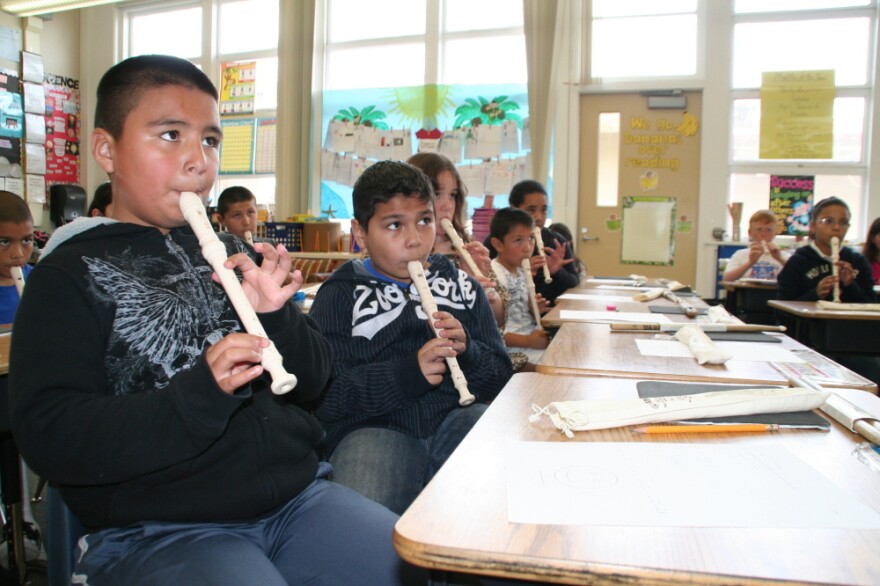With our free press under threat and federal funding for public media gone, your support matters more than ever. Help keep the LAist newsroom strong, become a monthly member or increase your support today.
Fractions Curriculum Strikes Right Note In California

Math teachers know that fractions can be hard for the average third-grader. Teachers at a public school in San Bruno, Calif., just south of San Francisco, are trying something new. They're teaching difficult math concepts through music, and they're getting remarkable results.
At Allen Elementary School, a roomful of third-graders sits facing music instructor Endre Balogh, their backs straight, eyes ahead, beating a mouse pad with drumsticks. As Balogh taps a rhythm, the students follow.
"What kinds of notes did you play?" Balogh asks. "Jasmine, what do you think?" Jasmine gets it right. "Eighth notes, very good."
These students are learning fractions.
"So, like two-eighths plus six-eighths, you have eight-eighths. But, since it's in the music, it equals a whole note," explains 9-year-old Donte Arevalo.
In the program, called Academic Music, students first learn the basics of reading notes. Then, they learn how to add notes, which is essentially adding fractions. Balogh is drawing the music notes on the board and adding them together.
"How many eighth notes do you see?" he asks. A student responds correctly. "Now, I wonder, what should I write here because this is tricky?" Another student has the right answer.
From there, it gets harder. Students learn how to add uncommon denominators and multiply fractions.
San Francisco State University researcher Susan Courey designed the curriculum with Balogh in 2007, because as a former third-grade teacher, she knows how tricky fractions can be.
"If you say, what's bigger one-eighth or one-fourth, they'll say one-eighth because eight is bigger than four," Courey says. It's all about visualization.
"But our students — because of the notes — know that all those little tiny eighth notes are a lot smaller than a whole note or a half note," Courey says.
In this class, more than half the students are English-language learners. Classroom teacher Gina Grites says Academic Music has especially helped her students, such as a little girl who volunteers to solve a problem, even though she barely speaks English.
"She knew that it was four counts and put it into a fraction," Grites says. "Just to have her get up and present in front of a class is a really big deal, and she raised her hand and wanted to, so I'm seeing a lot of these kids open up and want to try it, instead of hiding behind the desk and saying, 'Please don't call on me.' "
A recent study found that students who went through the program tested better on fractions. The average score of the Academic Music students was nearly double that of students in the regular math class. Courey says even low-performing students did better.
"That's what I, as a classroom teacher, want," she says. "I want to know that those students who typically are the underachievers are benefiting from the instruction that I'm providing."
In a less formal study, Allen Elementary School teachers compared their kids' math scores with third-graders in other district schools. Again, Allen students performed better.
Back in the classroom, 9-year-old Eric Bogren says he'd never played an instrument before Academic Music.
"It's really easy when it's music, but it's harder to do it when you're doing math," Eric says. For Eric, thinking of fractions as music notes, helps.
The curriculum designers hope to eventually make the program available for any third-grade teacher to use in the classroom.
Copyright 2022 KQED. To see more, visit KQED. 9(MDA1OTI3MjQ5MDEyODUwMTE2MzM1YzNmZA004))
At LAist, we believe in journalism without censorship and the right of a free press to speak truth to those in power. Our hard-hitting watchdog reporting on local government, climate, and the ongoing housing and homelessness crisis is trustworthy, independent and freely accessible to everyone thanks to the support of readers like you.
But the game has changed: Congress voted to eliminate funding for public media across the country. Here at LAist that means a loss of $1.7 million in our budget every year. We want to assure you that despite growing threats to free press and free speech, LAist will remain a voice you know and trust. Speaking frankly, the amount of reader support we receive will help determine how strong of a newsroom we are going forward to cover the important news in our community.
We’re asking you to stand up for independent reporting that will not be silenced. With more individuals like you supporting this public service, we can continue to provide essential coverage for Southern Californians that you can’t find anywhere else. Become a monthly member today to help sustain this mission.
Thank you for your generous support and belief in the value of independent news.

-
Doctors say administrator directives allow immigration agents to interfere in medical decisions and compromise medical care.
-
The Palisades Fire erupted on Jan. 7 and went on to kill 12 people and destroy more than 6,800 homes and buildings.
-
People moving to Los Angeles are regularly baffled by the region’s refrigerator-less apartments. They’ll soon be a thing of the past.
-
Experts say students shouldn't readily forgo federal aid. But a California-only program may be a good alternative in some cases.
-
Distrito Catorce’s Guillermo Piñon says the team no longer reflects his community. A new mural will honor local leaders instead.
-
The program is for customers in communities that may not be able to afford turf removal or water-saving upgrades.







